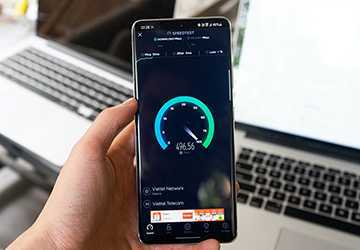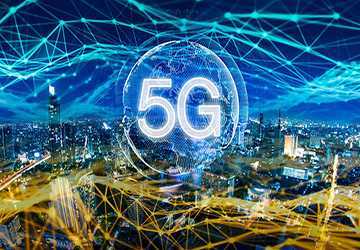How 5G is Transforming the Way We Connect
How 5G will revolutionize connectivity and data transfer
The emergence of 5G technology will change the way we connect and interact with technology. While 4G LTE served us well, offering decent speeds and connectivity, a speed comparison between 5G and 4G shows an unprecedented jump in data transfer rates. We're talking about a jump from 100 Mbit/s on 4G to 10 Gbit/s on 5G. The significant increase in speed enables real-time communications and ultra-high-definition content streaming with virtually no latency, setting a new standard for mobile networks.

Benefits of 5G to various industries
One of the most compelling benefits of 5G is its potential to revolutionize industries beyond mobile communications. For example, 5 G's low latency and high data rates in healthcare make remote surgery and patient monitoring more reliable and instantaneous. In the automotive industry, 5G can take the Internet of Things (IoT) to the next level and make smart cars more efficient through faster data exchange and real-time decision-making. Even in agriculture, 5G could enable more brilliant, automated agricultural technology, such as drones that transmit real-time data on soil and crop conditions.
Learn how 5G works.
When delving into how 5G works, it's essential to understand its architecture, which consists of an all-IP core network and a cloud-native platform. Unlike previous versions, 5G uses millimeter wave frequencies in the 24 to 52 GHz range instead of the sub-6 GHz spectrum used by 4G. These higher frequencies allow for faster data transmission but have the disadvantage of a shorter range and less penetration into obstacles. Therefore, to achieve robust 5G connectivity, it is necessary to deploy dense small cell networks to ensure consistent high-speed data transmission even in crowded urban areas.
Multifaceted user experience
With the advantages of 5G technology, the user experience will be significantly improved. With faster data speeds and lower latency, everything from gaming to streaming to online shopping becomes smoother and more efficient. Augmented reality (AR) and virtual reality (VR) technologies will also benefit users and provide a more immersive and responsive experience.
5G vs. 4G speeds in everyday life
Finally, if you're wondering how this affects your daily life, consider the speed difference between 5G and 4G when downloading a full-length HD movie. With 4G, it could take a few minutes or more, but with a 5G network, you can hit play in seconds. This leap in speed and efficiency is critical for critical, time-sensitive applications such as entertainment and emergency response systems.
The healthcare revolution brought about by 5G
Healthcare is poised to reap huge gains, given the benefits of 5G. The introduction of 5G will redefine telemedicine, allowing doctors to consult with patients and provide real-time medical advice and diagnosis with virtually no delay. Imagine the potential for remote surgery, where expert surgeons can operate robotic arms in real-time from thousands of miles away. This is no longer science fiction; it's reality. This is a realistic possibility, given the speed differences between 5G and 4G.
Additionally, how 5G enables fast data transmission will allow seamless coordination between IoT devices in healthcare. By monitoring patient data in real-time, healthcare providers can be notified immediately if a patient's condition worsens, thus shortening the time to intervention. Medical records, high-resolution images, and even 3D MRI scans can be shared instantly, facilitating fast, accurate diagnosis and treatment planning.
Transforming retail and e-commerce with 5G
In retail and e-commerce, 5G may usher in a new era of shopping experience. The benefits of 5G also extend to real-time analytics and personalized customer engagement. For example, 5G-enabled retail stores can use facial recognition and real-time data analytics to offer customized promotions as customers enter, significantly improving the shopping experience. 5 G's speed relative to 4G also means mobile payments are faster and more reliable, making transactions worry-free and secure.

The transformative potential of 5G in IoT and smart cities
An often under-discussed aspect of 5G technology is its ability to push the Internet of Things (IoT) and innovative urban applications to unprecedented heights. The benefits of 5G are not limited to faster downloads or smoother streaming; they extend to creating a more connected and efficient world. 5 G's lower latency and higher bandwidth create the conditions for a more innovative and sustainable environment.
Imagine a city where traffic lights, public transportation, and waste management systems are interconnected and run on real-time data. This is not a distant dream but a reality that can be achieved through 5G. Fast data transfer can speed emergency response and save lives in public safety. If sensors send real-time parking data directly to the car's navigation system, even everyday tasks like finding a parking space can be accomplished quickly.
When comparing the speeds of 5G and 4G, the former is about more than just faster downloads and enabling fast, real-time data analysis. High speed and low latency can provide lightning-fast decision-making processes for companies using data analytics and machine learning algorithms. For example, retailers can analyze consumer behavior in real-time, allowing for a more personalized shopping experience and more effective inventory management.
How does 5G enable all of this? The answer lies in its network-slicing capabilities. Unlike 4G networks, 5G allows the creation of multiple virtual networks within the same physical network infrastructure. This means that different types of services can be assigned specific "slices" to ensure optimal performance for each service. For example, one area could be optimized for low power consumption of IoT devices, while another area could prioritize autonomous vehicles.
To sum up, 5G is not just an upgrade; This is a revolutionary technology that is changing how we interact with the world and how different industries operate. From dramatically increased speeds to groundbreaking applications across multiple domains, 5G is the future of connectivity.
Related Posts
- 4 Most Important Gadgets for Remote Work to Boost Productivity in 2023
- Guide to Building Your Gaming PC
- 5 Best Practices for Data Backup and Recovery
- 4 Ways Smart Home Devices Can Simplify Your Daily Routine
- Building Resilient Networks: Cybersecurity and Reliability
- The Top 10 Machine Learning Libraries Transforming Data Science in IT